Contents
- How to determine the time of sowing tomatoes for seedlings
- Preparation of soil for sowing
- Preparation and sowing of tomato seeds for seedlings
- Seedling watering frequency
- Temperature regime for growing tomato seedlings
- Picking tomatoes
- Fertilizing tomato seedlings after picking
- Organization of lighting seedlings of tomatoes
- Hardening of tomato seedlings before planting
- planting tomatoes
Tomatoes are a favorite vegetable of most gardeners. In an open area, a crop can be grown even in the climatic conditions of the Moscow region, Siberia, the Urals, the main thing is to correctly determine the timing of sowing seeds for seedlings. The tomato bears fruit well and grows in the Non-Black Earth Region, if the beginning of the growing season takes place in an artificially created microclimate. Growing seedlings of tomatoes for open ground at home is available to every gardener, you just need to strictly observe the entire technology of this process.
How to determine the time of sowing tomatoes for seedlings

Now you can find a lot of advice on determining the exact dates for sowing tomatoes for seedlings. Someone trusts the lunar calendar, and someone other sources. I must say that only a vegetable grower can determine the exact date of sowing, according to the local climate. Suppose, in the middle lane, the timing of planting tomatoes in the garden is determined from the third decade of May, capturing the first days of June. From here, tomato seeds are sown in March-April. However, this concept is loose. Indeed, even in two neighboring cities of the same region, weather conditions may vary.
To deal with determining the exact date for planting tomato seedlings in open ground, let’s look at a few basic factors:
- It is necessary to plant tomato seedlings during the period of 50–60 days of age. Undergrown or overgrown plants do not take root well, and bring a small harvest.
- By the time the tomato seedlings are planted on the street, a stable night temperature of at least +15 should be established.оC.
Guided by these factors, the vegetable grower must independently determine the optimal date for sowing and planting seedlings, for example, for open ground in the Moscow region.
Preparation of soil for sowing
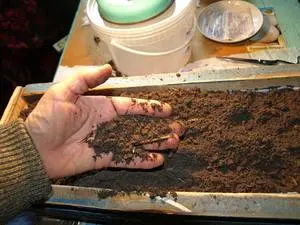
After you have determined when to sow tomatoes, you need to take care of the preparation of the soil. Economic gardeners do not trust store soils, and prepare it themselves. There are many options here. Usually these are mixtures of several components. Quite often, a mixture of an equal amount of peat and sand is used for seedlings of tomatoes. Another popular soil of three components is also in equal proportions: peat, humus, sod land.
Many vegetable growers for seedlings gain only garden soil. This option is very good. Tomatoes immediately get used to the composition of the soil on which they will grow all summer. When using this method, the best survival rate of transplanted tomatoes is observed. Land has been collected from the garden since autumn. In winter, she is kept in a cold barn so that most pathogens freeze to death. Before planting, the soil is disinfected by calcining in the oven at a temperature of 100оC, plus watered with a cool solution of potassium permanganate.
For those who like to plant tomatoes in store soil, various mixtures are sold. They can be made for a specific culture or universal. The advantage of such soil is that it does not need to be additionally fed with fertilizers, which is indispensable for self-preparation of the soil. The store mix contains all the necessary trace elements, and is completely ready for use.
Preparation and sowing of tomato seeds for seedlings
Preparing good soil for tomato seedlings is only half the battle. Now it’s time for the tomato seeds. Until the moment of sowing with grains, you still have to tinker.
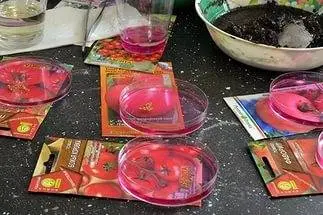
Each grower has his own method of preparing tomato seeds. Let’s look at one of them:
- The process of preparing tomato seeds begins with culling. You can manually sort through the seeds, discarding all broken, empty and rotten specimens. It is easier to do this with plain water or a weak saline solution. Full-bodied seeds immersed in liquid will sink, and all empty ones will float to the surface.
- The process of disinfection of tomato seeds is required. A simple recipe is based on immersing the grains in a saturated solution of potassium permanganate. After half an hour, the shell of the grains becomes brown. They are pulled out of the solution, and then washed under running water. Next, prepare a solution of 1 liter of water plus 1 g of boric acid powder. In this liquid, tomato seeds stay for a day.
- After disinfection, the seeds are subjected to soaking. To do this, use melted, rain, or purified water. Soak tomato seeds throughout the day. Do not soak tomato seeds in tap water. Even a small concentration of chlorine will harm the embryos.
- Hardening of tomato seeds causes a lot of controversy among vegetable growers. Some welcome this method, others argue that it will be enough to harden the seedlings. If it is decided to harden the tomato seeds, they are placed in the refrigerator for a day.
- The final preparation is the germination of seeds. Tomato seeds are wrapped in ordinary wet gauze or cotton cloth, put on a tray and put in heat, but not on a radiator.
Tomato seeds will begin to germinate around the fifth day. By this time, prepare containers for planting and soil.

Plastic cups, cut PET bottles, boxes, juice bags, magazine cassettes, etc. are used as containers for tomato seedlings. The inner walls of the containers must be disinfected with a cool solution of potassium permanganate. The filled soil is additionally disinfected again with a weak solution of potassium permanganate. The soil is first lightly rammed, watered, and then loosened again.
In boxes, grooves 1,5 cm deep are cut with a finger along the surface of the soil, where tomato seeds are decomposed in 3 cm increments. It is important to maintain a row spacing of about 5 cm wide, otherwise the seedlings will be very dense. From 1 to 3 tomato seeds are sown in separate cups. It is still better to sow 3 grains. When the sprouts germinate, the two weak ones can be removed, and the healthy seedling will develop further.
The tomato seeds laid out along the grooves are covered with loose soil on top. The containers are tightly covered with a film, creating a greenhouse effect inside. Tomato crops stand in a warm room with an air temperature of about +25оC. The film can be removed only after all seeds have germinated. This usually happens after 5-7 days. At this time, it is important not to lower the room temperature until the seedlings have adapted.
Hatched seedlings of tomatoes are watered on the second day after removing the film. This is best done from the sprayer directly under the root. It has been noticed that the implementation of watering before lunch contributes to the intensive growth of tomato seedlings, plus the stem of the plant becomes more powerful. As the soil dries, loosen the soil under the plants. Coco substrate shows good results in moisture retention and oxygen access to the roots. It is scattered in a thin layer over the entire soil, where tomato seedlings grow.
Seedling watering frequency
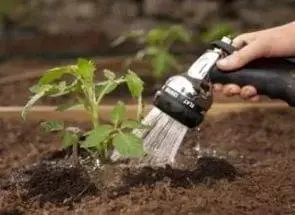
It is believed that good tomato seedlings are obtained with infrequent watering. Moreover, this process is combined with the application of fertilizers. The soil must be kept slightly moist at all times, but not wet or dry. Best of all, tomatoes perceive watering in the morning. Usually adhere to the frequency – 1 time in 5 days. Water temperature for irrigation should always be at room temperature. From the cold liquid, there is a possibility of the appearance of a “black leg”, plus the seedlings slow down growth and become weak.
Temperature regime for growing tomato seedlings
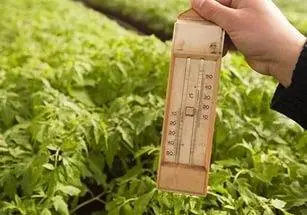
The intensity of development of tomato seedlings depends on the temperature regime. It is optimal to adhere to the daily positive temperature in the range of 17–19оFrom and 15–16оHappy night. If it is colder indoors, tomato seedlings will slow down in growth. From such plants, fruiting should be expected 2 weeks later.
Picking tomatoes

If the tomatoes were sown in a common box, after about 15 days you will have to pick the seedlings. By this time, the plant acquires two true leaves. The essence of picking seedlings is to pry each tomato with a small spatula, after which the seedlings, together with a clod of soil, are transplanted into separate cups.
Many have probably seen tomato seedlings on the market, sold in homemade plastic cups. This is the most economical option used when picking tomatoes. To make such a cup, a sleeve is made from a strip of polyethylene 25 cm wide. Joints can be soldered with an iron through a newspaper or sewn on a sewing machine. The resulting tube is cut into pieces about 10 cm long. Such cups do not have a bottom, therefore, when filling the soil, they are placed on a pallet tightly to each other. As the seedling’s root system expands, it will hold the soil together and prevent it from falling out. If desired, a piece of film can be placed inside the cup, making at least some bottom.
Before transplanting a seedling, each cup is filled by a third with soil, a pickled tomato is placed in the center, after which all gaps are filled with loose earth. The soil level should reach the cotyledon leaves of the tomato, but 1/3 below the top edge of the glass.
The transplanted tomato is poured with warm water along the edge of the glass so that the seedling is well established in the new place. From above, the soil is sprinkled with a thin layer of humus with wood ash, after which mulching is done. Picked tomatoes should not be taken out for a week under hot sunlight. In order for the plants to take root better, it is optimal to maintain the soil temperature within 20–25оC.
Fertilizing tomato seedlings after picking
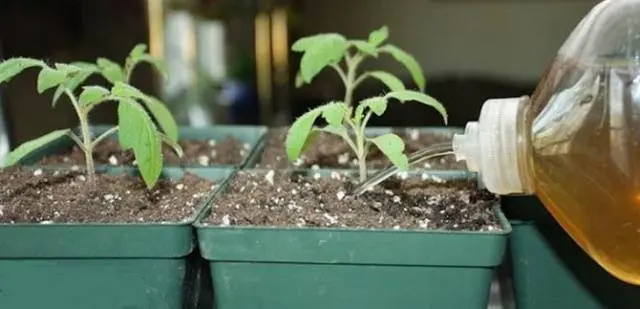
After picking, tomato seedlings must be fed. A nutrient solution is prepared from chicken manure by diluting 1 part of it in 20 parts of water. The liquid must be infused for at least three hours, only then it can be used. The first time seedlings are poured 14 days after picking. After 15-20 days, do it again. The third time, tomatoes are poured 10 days before transplanting into open ground.
Sometimes, as a top dressing, spraying seedlings with skimmed milk is used – skimmed milk. This will save the plants from some viral lesions.
Organization of lighting seedlings of tomatoes
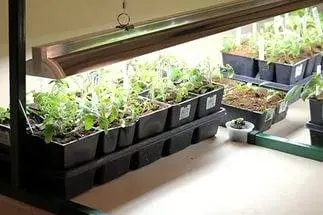
Lack of lighting can be identified by elongated seedlings and dull foliage. Daylight hours are not enough for plants, so in the morning and in the evening it is necessary to turn on artificial lighting. Conventional incandescent light bulbs emit a lot of heat. They cannot be brought closer to tomato seedlings closer than 60 cm. It is optimal for these purposes to use LED, fluorescent or special fitolamps.
Hardening of tomato seedlings before planting
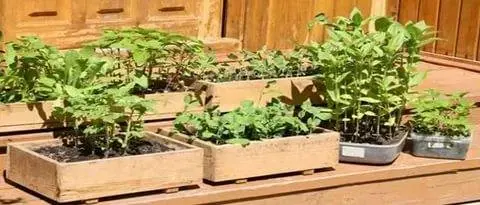
Hardening of tomato seedlings for open ground helps to strengthen the immune system of plants, adapts them to a permanent habitat. From April, when warm days set in the street with a temperature of at least +12оC, tomatoes are taken out into the shade. The length of time spent on the street is increased gradually. After a week, seedlings can be accustomed to sunlight. This should not be done immediately to avoid leaf burns.
planting tomatoes
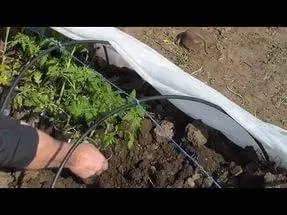
Tomatoes for open ground are considered ready for planting when full 6–9 leaves appear. Usually, the height of the stem at this time reaches 25 cm. The readiness for planting seedlings of early tomato varieties is determined by the formation of the first inflorescences. When the night temperature is stable at a minimum mark of +12оC, you can be sure that the planted plants will not die. However, the tomato is comfortable with a minimum night temperature of +15оC, so you will have to make temporary arcs of wire over the seedlings, and cover the plants with agrofiber or film.
Usually, experienced vegetable growers plant tomatoes in batches, and not all at once. This makes it possible to track the survival of plants, and in the event of the death of some tomatoes, there is always a supply on hand to replace them.
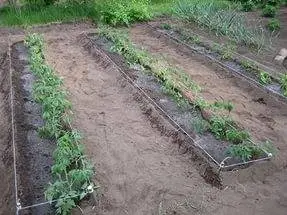
Holes for tomato seedlings are dug about 30 cm deep, although it all depends on the size of the root system. It is important to adhere to a planting pattern that depends on a particular variety. The best yield is observed when undersized bushes are located at a distance of 30 cm from each other, and between rows – 40 cm. For tall tomatoes, the step between the bushes is 70 cm, and the row spacing is 130 cm. However, these are general figures. Each variety has its own requirements: one likes thickening, and the other – freedom. The optimal planting pattern is indicated by the seed manufacturer on the package.
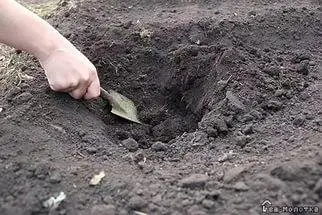
Seedlings are watered 2 days before planting. So, it will be better to be removed from the cups. The seedling is carefully placed with a clod of earth in a hole, sprinkled with loose soil, and rammed a little. Immediately, the plant must be watered under the root with warm water. If the plant tends to the ground, it is tied to a temporary peg.
Video about tomato seedlings:
Outdoor tomato seedlings need some time to adapt. The construction of temporary shelters will help to get an earlier and more abundant harvest of a delicious vegetable.









